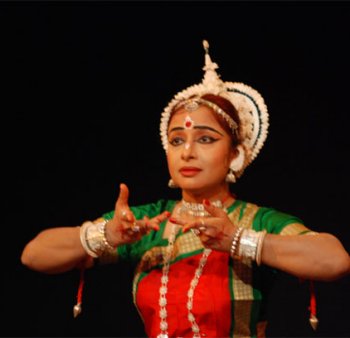
Guru Debaprasad
Das legacy comes alive
Tridhara
celebrates 2nd Odissi Dance Festival in New Delhi
- Dr. Bhabani Dikshit
e-mail: cnfworldfocus@gmail.com
October 4,
2009
The two-day dance
festival of the 2nd Guru Debaprasad Das Nrutya Parampara 2009 at
Stein Auditorium at New Delhi concluded recently was quite significant
in many ways as it gave an appropriate platform for the audience to clearly
distinguish the subtle dance nuances of the Odissi legacy of this great
Guru in comparison with another of his contemporary, the well known Guru
Kelucharan Mahapatra. Credit for this venture goes to Tridhara which
is a pioneering cultural organization that upholds the unique style of
Late Guru Debaprasad Das and promotes a synthetic gharana imbibing
essence from tribal and folk traditions. This organization has been founded
by Debaprasad Das, who was well known for his pure and unique style
of Odissi Dance. Debaprasad Das was the former professor of Odissi
Dance in Utkal Sangeeta Mahavidyalaya, Bhubaneswar. Now his able and efficient
disciple Guru Gajendra Kumar Panda is the director of Tridhara.
The function
was inaugurated by the doyen of culture Dr Kapila Vastayan amidst the eminent
Gurus Harekrishna Behera (Odissi Dance), Prabhakara Sreechandan
(Odissi Music) and Nilakantha Tarai (Sakhi Nata) who later
were felicitated for their contribution.
 Dr. Kapila
Vatsyayan inaugurates the festival
Dr. Kapila
Vatsyayan inaugurates the festival
|
Odissi dance presentation:
The first
item of Magalacharan reverberated with the Ganga Taranga
slokas when Ravankruta Shiva Tandava was performed by Guru Gajendra
Kumar Panda. His dynamic dance demonstrations vividly portrayed Shiva
Tandava manifestations and initiated for an ensuing subtler Odissi
performances by the disciples of Debaprasad Das legacy followed by it.
Astapadi
(Nindati Chandana) as a part of Abhinaya accrues from Jayadeva's
Gita Govinda and was performed by Anita Singh Deo with her immaculate
expressional dance. The viraha expressions of the dancer reflected
the emotional content through her well crafted mudras.
 Gajendra
Kumar Panda
Gajendra
Kumar Panda
|
 Gayatri
Chand
Gayatri
Chand
|
In India, the
Sun god has been worshipped from time immemorial, as a symbol of health,
strength, vitality and immortal life. While offering prayers to the Sun
god, Gayatri Chand performed the devotional item Sooryastaka in
her full spirits. She surcharged the auditorium with her completely articulate,
blissful, immensely graceful and energetic dance movements ensuring a perfect
harmony of flames of inner passion for her dedication to the Sun god along
with the spiritual urge for merging altogether with the all powerful planet
(grahapati) who is the head of all planets. The Sooryastaka
sequences of the dancer based on the Raga Bairagi and the Jati
Tala made a superb impact. Sooryastaka in such unique Odissi
form manifested a rich amalgamation of Gayatri Chandís merging of her dance
with her soul in total devotion at the backdrop of the pure vocal and music
composition of Guru Ramahari Das. It was a harmonious Sooryastaka
uniquely blended by Gayatri Chand.
In the item Pallavi,
Sangeeta Dash did splendid Odissi performance along with the music composed
by Ramahari Das based on Raga Madhyamadi, choreographed by Sangeeta
Dash herself. The themes of cloud, peacock and nayika could be vividly
seen.
The most vibrant
programme of the Tridhara Odissi evening was the Mokshya dance recital,
the concluding item of the first day. According to Hinduisim, salvation
is the ultimate goal of human life. Hence, in this item, Gajendra Panda,
Sangeeta Dash and Gayatri Chand with all their force performed Mokshya
in a very fast speed to achieve this ultimate goal. Liberation from bondage
was clearly visible in the faces of these dancers.
The second
day was also similarly full of events like Dasavatar, Sivastaka, Dandanata
and Sakhinata etc. Both the days, the cultural performances evoked
applause from the audience.
The writer
is the Managing Editor, World Focus, based in New Delhi. |

